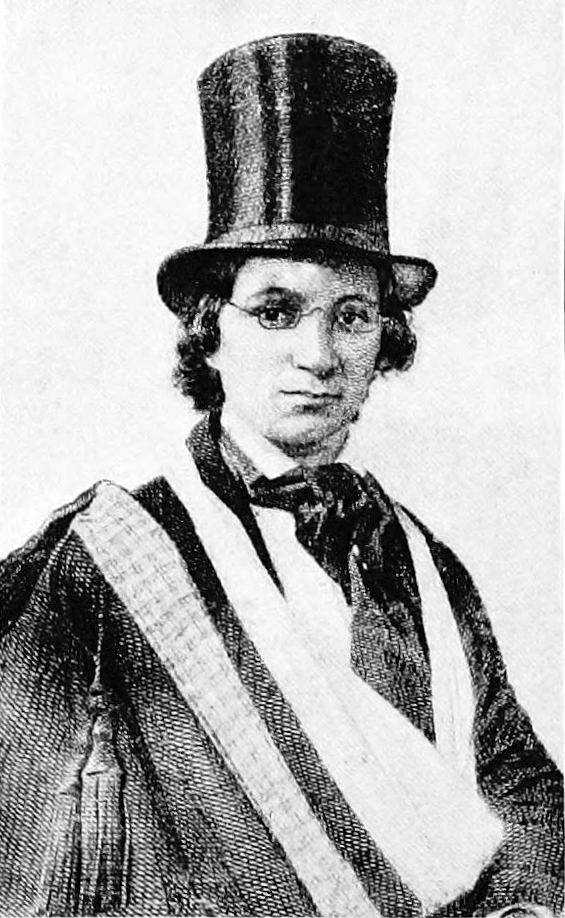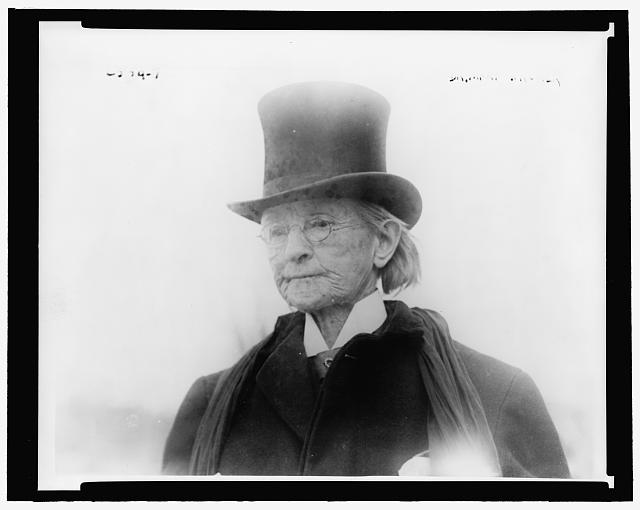Perhaps my favorite take-away from my co-op with the MFA Boston is the beginnings of a research project. In the last few weeks of my winter quarter, I’ve begun constructing a timeline of arrests, laws, and court cases which target cross-dressing through US history. It has steadily become one of the most engrossing projects I’ve ever started.
While conducting research for an exhibit on gender-bending and fashion (which I talked about in a previous post) I began to look into cases in which women had been arrested for wearing pants. Michelle Finamore recently published an article, The Audacity of Pants, which touches on the cultural shifts that took place in America with the simple action of women donning trousers. She considered the subject through the lens of women’s appearances in formal tuxedo wear under the Hollywood spotlight, from women such as Marlene Dietrich in her iconic Le Smoking suit to Barbra Streisand making history when she became the first woman to wear a formal suit to the Oscars.
For Streisand, while the press was never that explicit about the pants being the issue, there was an undercurrent of disapproval in some of the coverage. A number of journalists referred to it as pajamas, suggesting an informality that was simply not appropriate for evening wear. Even now, amidst the seemingly endless award shows, the Academy Awards are still arguably the most visible platform for Hollywood fashion display. –The Audacity of Pants
Well before Hollywood began to showcase icons such as Dietrich or Josephine Baker, both of whom would challenge the traditional gender narrative through their choice of performance clothing, the path to their liberating attire had to be paved by women whose lives were far from the spotlight of entertainment and glamour. At the start of my research, the first example of a woman in the US being arrested for wearing pants that I could immediately recall was the case of Helen Hulick in 1938. Hulick was held in contempt of court and sentenced to jail for five days when she refused to follow a judge’s orders to wear a dress when she appeared to testify against two suspected burglers. She only served one hour of her 5-day sentence, and returned to court in a dress months later. While Hulick is a recent example of a woman being sent to jail for wearing pants, the earliest example I’ve found (yet) was a young woman by the name of Emma Snodgrass, who was arrested multiple times for publicly wearing pants in 1852 and ’53.
Snodgrass’s timeline has been a bit of a challenge for me to piece together, but from what I can tell she was arrested in Boston on November 30th of 1852 for what seemed to have been the second time that month, for traveling in the city while wearing pants and other masculine-style clothing. She was seen at a museum prior to her arrest “sporting a model cane, Kossuth hat, frock coat, pants, &c., not to mention an ambitious shirt-collar and flaming scarf.” It would appear that in the case of both arrests, she was simply sent home to her father in feminine attire. She was arrested again on December 28th and brought to court on charges of vagrancy the next day, which the judge dismissed. She was arrested again on December 31st, along with a companion by the name of Harriet Finch, who “sported a Kossuth hat, shiny gaiters, model cane, black pants coat,” and had been using male pseudonyms. It was later reported on January 10th that Harriet “was sentenced to the House of Reformation for six months. This was afterwards so qualified as to permit her twenty-four hours to leave the city -which she promised to do.” One of the last sightings of Emma Snodgrass was reported by The Daily Dispatch, which said she’d been spotted in Albany while registering her name as “Henry Lewis,” and that she claimed to be traveling to either California or Australia.
The New England Historical Society article on Snodgrass lists her travels in greater detail, but I hesitate to use their primary source. Unfortunately, the compilation of articles by Will Johnson no longer link back to his sources, and not even the link attached to his name as the author is functional. For now I’ve compiled as many original source accounts of Snodgrass as I can currently access, and I plan to see what else I can find through Antioch’s resources once I’m back in Yellow Springs for the spring quarter.
Yet far more impressive than Snodgrass’s persistent public appearances is the earliest example I’ve found (yet) of a woman breaking the law by wearing pants, which took place just four years prior with the incredible case of Ellen Craft in 1848.

Ellen Craft, Public Domain, Link
Ellen and her husband, William Craft, were both slaves in Macon, Georgia. In December of 1848, they were able to make their terrifying escape to freedom thanks to Ellen’s gender-bending portrayal as a white man traveling with his loyal attending slave (William). They traveled from Macon to Philadelphia over the course of four days. Ellen’s father had been a white slave owner, and her skin was so fair that she was sometimes mistaken for a member of the white household. It was William’s idea for Ellen to disguise herself. They cut her hair, she put on pants that she’d made herself, and she wore a top hat and spectacles. They wrapped bandages around her face to cover her lack of facial hair, and put her right arm in a sling so that she wouldn’t be expected to sign her name along the way (as neither Ellen or William were literate). During their travel she sometimes also pretended to be disabled.
Pondering various escape plans, William, knowing that slaveholders could take their slaves to any state, slave or free, hit upon the idea of fair-complexioned Ellen passing herself off as his master—a wealthy young white man because it was not customary for women to travel with male servants. –The Great Escape From Slavery of Ellen and William Craft
This particular example also sheds light on what might be the most significant root of the systemic targeting of cross-dressers by authorities in our country: racism. In the book, Whitewashing America: Material Culture and Race in the Antebellum Imagination, author Bridget Heneghan points out on page 116 that opponents of the Bloomerist movement sometimes attacked the femininity of bloomer-wearers by comparing their clothing to slave garb, or other clothes associated with African American women. Peter Boag describes in his book, Re-Dressing America’s Frontier Past, that cross-dressing accounts in the 19th and 20th century West usually recorded the person’s race unless they were white, and often in derogatory or slanderous terms.
Only one source that I came across referred to a white male-to-female cross-dresser’s race. Significantly, the newspaper that divulged this identity did so for the purposes of questioning that individual’s character because he otherwise associated with African Americans: in 1897, Topeka, Kansas, police arrested a twenty-six-year-old resident female impersonator known only as “LeCroft,” for dressing up in women’s clothing to rob men. The paper reporting the incident described LeCroft as “a white man who lives with negroes … and had traveled with minstrel company.” (Boag)
Boag follows with multiple examples of the narrative which followed individuals of color arrested for cross-dressing, including how the narrative would change once it was realized that those individuals weren’t white. Like Heneghan, Boag also identifies how women of color in particular were stripped of their feminine identities. The book U.S. Women’s History: Untangling the Threads of Sisterhood, a collection of essays by multiple authors, also confirms the persecution of black womanhood, and identifies the necessity of black women to disguise themselves in men’s clothing, because the mobility of black slave women was even more controlled and criminalized than their male counterparts. Enslaved men could travel more easily than enslaved women in general, and could therefore escape more easily. U.S. Women’s History is the resource that brought my attention to the example of Ellen Craft, and the necessity for her to pass not only as a man, but as a white man.
The ability to pass as white was crucial to Ellen’s gender crossing –for whiteness was the key to the privileges of manhood that so many women sought. […The Crafts’] path to freedom was no Underground Railroad. Rather, it followed a course that accessed the privileges and freedoms of white manhood. –U.S. Women’s History: Untangling the Threads of Sisterhood

Harriet Tubman sometimes dressed as a man, one of the numerous methods of disguise she used to help slaves escape to freedom. Public Domain, Link
Cross-dressing as a tactic of disguise for run-away slaves likely aided the growing paranoia by authorities that women wearing pants or men wearing skirts were people attempting to trick others and hide their true identities for nefarious reasons. Ruthann Robson, in her book Dressing Constitutionally: Hierarchy, Sexuality, and Democracy from Our Hairstyles to Our Shoes, makes the connection between cross-dressing and the rise of vagrancy arrests, as the fear of disguise (63). Originally in response to the anti-rent riots, New York passed an anti-vagrancy statute in 1845 which defined a vagrant as “Every person who, having his face painted, discolored, covered or concealed, or being otherwise disguised, in a manner calculated to prevent him from being identified, shall appear in any road or public highway, or in any field, lot, wood or inclosure, may be pursued and arrested” under section five. For over a century after it was passed, this New York vagrancy statute has been repeatedly used to target cross-dressers, on the basis that their clothing acted as a “disguise” of their true identities. Examples include the arrests of Jenny F. Westbrook in 1882 and 1883 (whose case is also detailed in the work of author Carol Mattingly, whom I introduce below), the case of the People v. Luechini in 1912, and the case of the People v. Archibald in 1968.
Included in the list of cross-dressers charged with vagrancy is also Emma Snodgrass, whose charges were said to be dismissed because her “male attire” was “really little or no disguise, her form being so light and fragile, and her feature and manners so entirely feminine,” and because she had too much money to be a vagrant. Heneghan hints toward the link of classist implications of enforced gender-norms and dress which tie into the sentiments of racism (“the paucity of dress suffered by slaves,” 116). Heneghan also references the newspaper accounts of Emma Snodgrass and the analysis of the “contradictory” language in those articles by Mattingly.
Carol Mattingly is the author of Appropriate[ing] Dress: Women’s Rhetorical Style in Nineteenth-Century America. In chapter 4 of her book, “The Language of Passing and Desire: The Rhetoric of Cross-Dressing,” Mattingly examines several examples of arrested “proper” women cross-dressers being released into the custody of a man (usually their father, husband, or brother) with only a warning.
For the most part, women who thus appeared in men’s clothing could be treated kindly and in good humor if the breech in decorum appeared to be a solitary lark. If women feigned modesty, authorities simply reprimanded them. In one reported case, the cross-dresser resorted to a display of femininity; she was accompanied by a man, conducted herself “with propriety,” confessed her transgression, and pleaded with the official in charge to protect her anonymity -all acceptable feminine behavior. Such women were generally dismissed into the care of their escorts[…]” (Mattingly, 102)
Mattingly states that the primary reason that Snodgrass dodged a prison sentence was because her father was an officer with the New York Police Department, meaning that her class status got her out of trouble. Mattingly also makes this connection with the example of Dr. Mary Walker, although she also describes how this effect wore off as Dr. Walker aged and lost her impression of femininity over time.

Dr. Mary Walker, 1912, image via the Library of Congress.
Dr. Walker has become my personal absolute favorite example of criminalized cross-dressers. Just from what I’ve found so far through the Library of Congress newspaper archive, Chronicalling America, Dr. Walker was arrested on seven separate occasions for wearing pants- eight occasions if you count an arrest in 1874 over a dispute with her tenant, which the Chicago Daily Tribune interestingly suggests might not have happened if she’d maintained her assumed “masculine” authority of wearing pants without the compromise of a skirt over top of them, which discredited her as a “badge of feminine servitude.” She was arrested New York in 1866, in Kansas City in 1869, threatened with arrest in New Orleans in 1870, arrested in Baltimore in 1873, seems to have been arrested in Brooklyn at some point, was arrested again in New York in 1878, arrested in Providence in 1886, and arrested in Chicago in 1913 at the age of 80-years-old. Dr. Walker wore pants under her skirt and a man’s coat to her wedding in 1856 (and refused to take her husband’s last name, as well as omitting “to obey” from her vows). Most impressively, she is the only woman to this day to have been awarded the Congressional Medal of Honor, which she received for her part as a surgeon in the American Civil War. During the war she wore a modified version of the male Union uniform, and refused to wear the women’s clothing provided for her after she was taken prisoner by the Confederates. Dr. Walker was also awarded the right to wear men’s clothing by an act of congress after the war. After her death in 1919 at the age of 87, Dr. Walker was buried in one of her suits. In 1982, the US Post Office issued a stamp in her honor, but interestingly the chosen image for the stamp is uncharacteristically lacy and feminine for Dr. Walker.
Sorting through all of these resources, reading these stories of perseverance in the face of oppression, the dialogues and analysis of gender and personal identity, examining the root reasons for which both state and federal authorities believe it to be in their best interests to enforce the binary concept of strictly male or female gender, I feel as though I’ve tumbled down a perpetual rabbit hole of historical insight. Suddenly I’ve begun to recognize the repetitive nature of the human condition across time, and how similar the events happening today really are when compared to the events of the past. Part of the reason Michelle Finamore first dove into the idea of fashion and gender-bending as the makings of an exhibit is because of how this issue has come to the forefront of our cultural dialogue in recent years, especially as young people in the US grow bolder in exploring their identities outside of the constructed cookie-cutter notions expected of them. Exploring non-binary personal gender identity isn’t new. This blog post doesn’t begin to cover the extent of what I’ve found as I continue to tumble (I’ve barely mentioned examples from the 20th and 21st century!), but I’m going to continue researching and compiling information on this subject well after my co-op ends this week. I’ve promised Michelle that I’ll email her with new finds and updates to my timeline, and that I’ll try my hardest to come to her exhibit when it finally opens (likely not until December of 2018, at the earliest). I’m not sure what form this project will have taken by the time I’m through, but I’m excited to make it happen. For now, I’m calling this project Fashion Crime.
Below is a list of suggested reading if you’re interested in the topic of arrests, laws, and court cases which target individuals for cross dressing.
An Intimate Affair: Women, Lingerie, and Sexuality (book), by Jill Fields
Appropriate[ing] Dress: Women’s Rhetorical Style in Nineteenth-Century America (book), by Carol Mattingly
Arresting Dress: Cross-Dressing, Law, and Facination in Nineteenth-Century San Francisco (book), by Clare Sears
Beware the Masher: Sexual Harassment in American Public Places, 1880-1930, by Kerry Segrave
Dressing Constitutionally: Hierarchy, Sexuality, and Democracy from Our Hairstyles to Our Shoes (book), by Ruthan Robson
Re-Dressing America’s Frontier Past (book), by Peter Boag
Sexual Orientation, Gender Identity, and the Law in a Nutshell (book), by Ruth Colker
TransAntiquity: Cross-Dressing and Transgender Dynamics in the Ancient World (book), edited by Domitilla Campanile, Filippo Carla-Uhink, and Margherita Facella
U.S. Women’s History: Untangling the Threads of Sisterhood (book), by Leslie Brown, Jacqueline Castledine, and Annie Valk
When Everything Changed: The Amazing Journey of American Women from 1960 to the Present, by Gail Collins
Whitewashing America: Material Culture and Race in the Antebellum Imagination (book), by Bridget T. Heneghan
“Arresting dress: A timeline of anti-cross-dressing laws in the United States” (article/timeline), by PBS
“Challenging the Apartheid of the Closet: Establishing Conditions for Lesbian and Gay Intimacy, Nomos, and Citizenship, 1961-1981” (article), by William N. Eskridge Jr.
“Criminalized Crossdressing” (article), by David Duffield
“Dressed to Excess” (article), by Bill Manson
“#TBT: When Cross-Dressing Was a Crime” (article/book review), by Advocate






